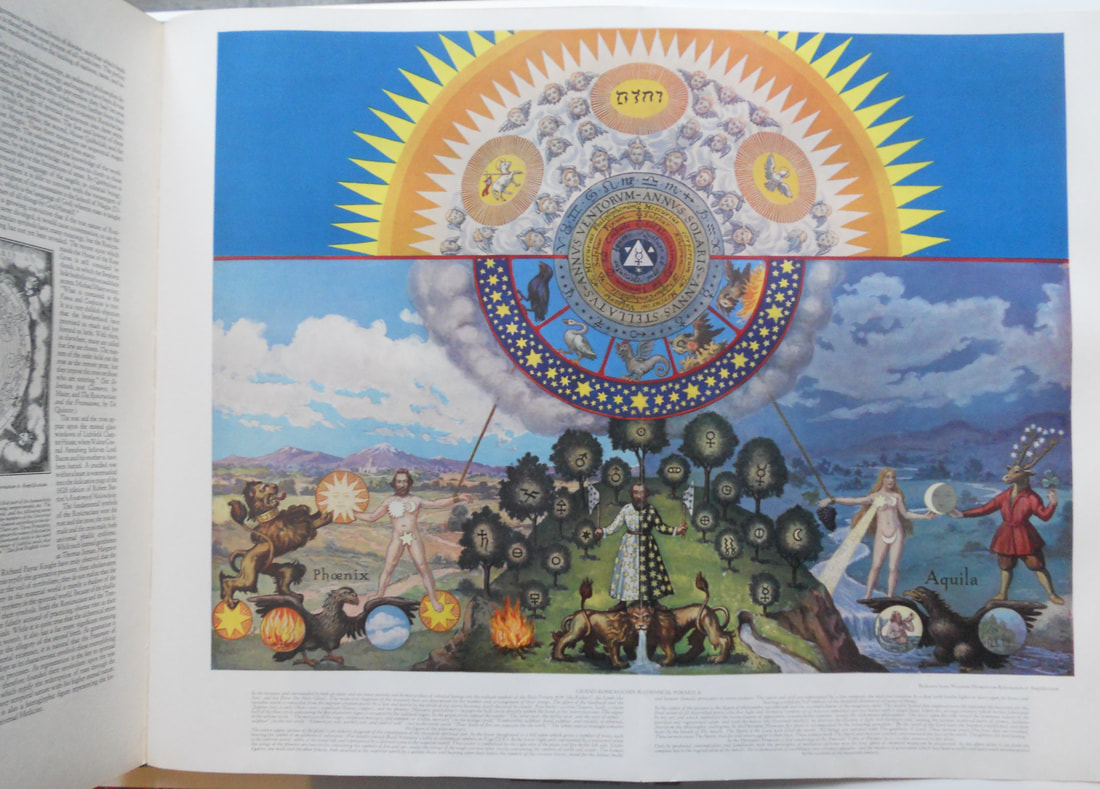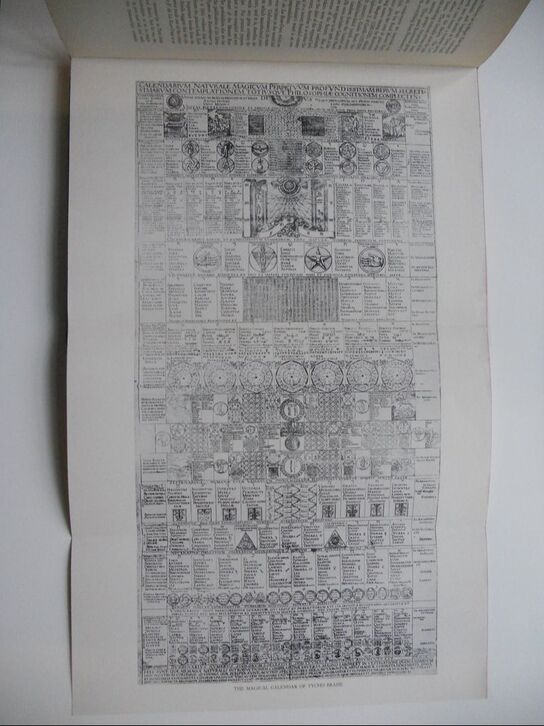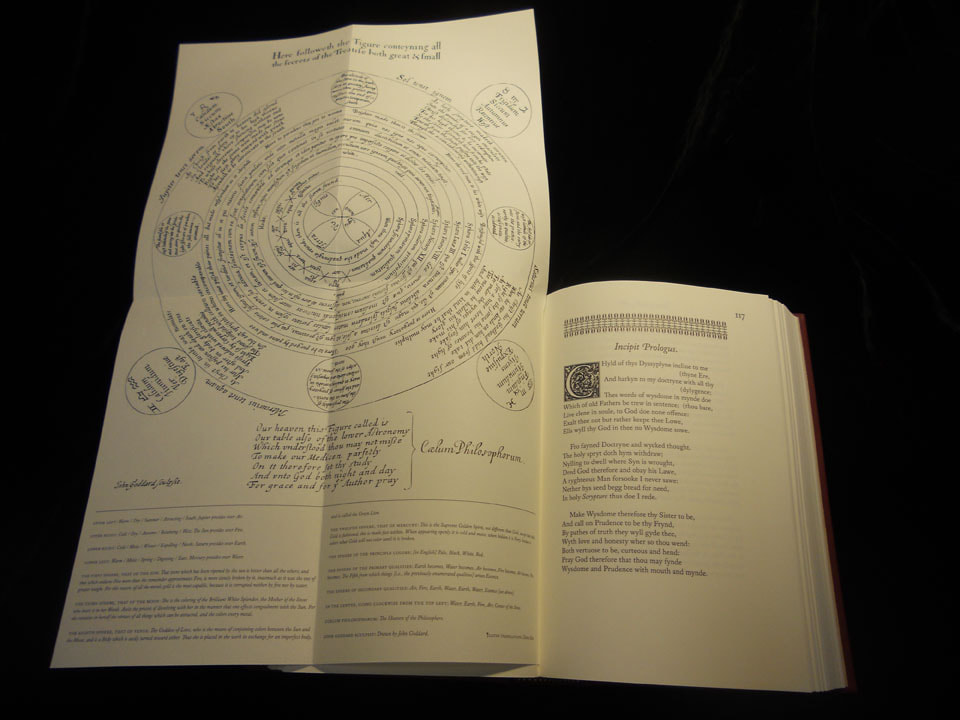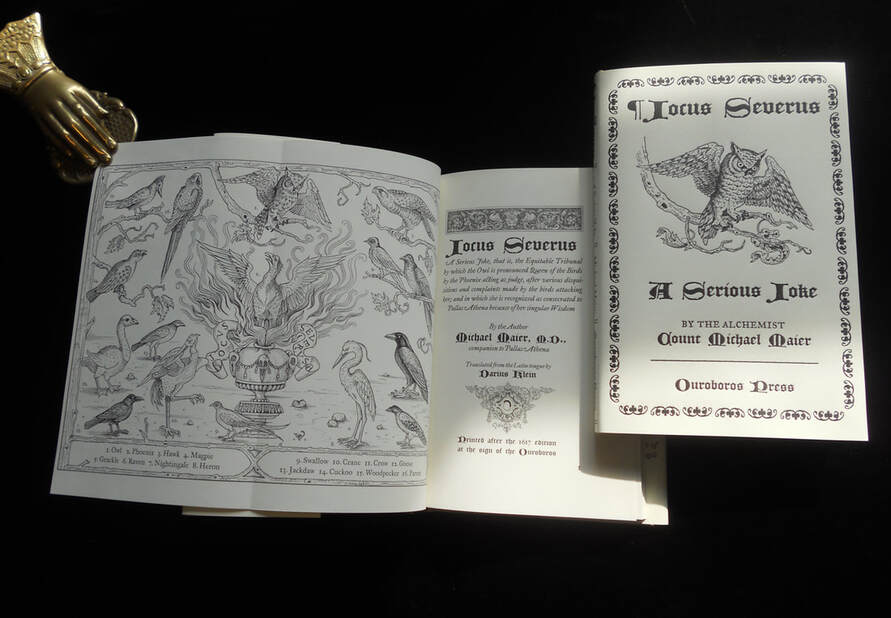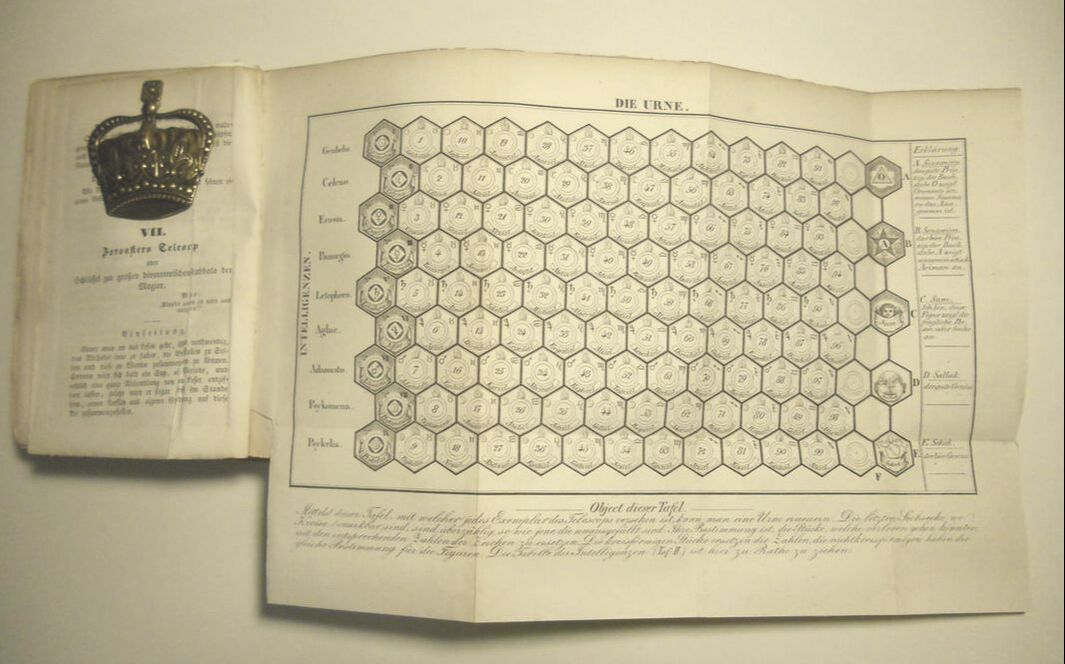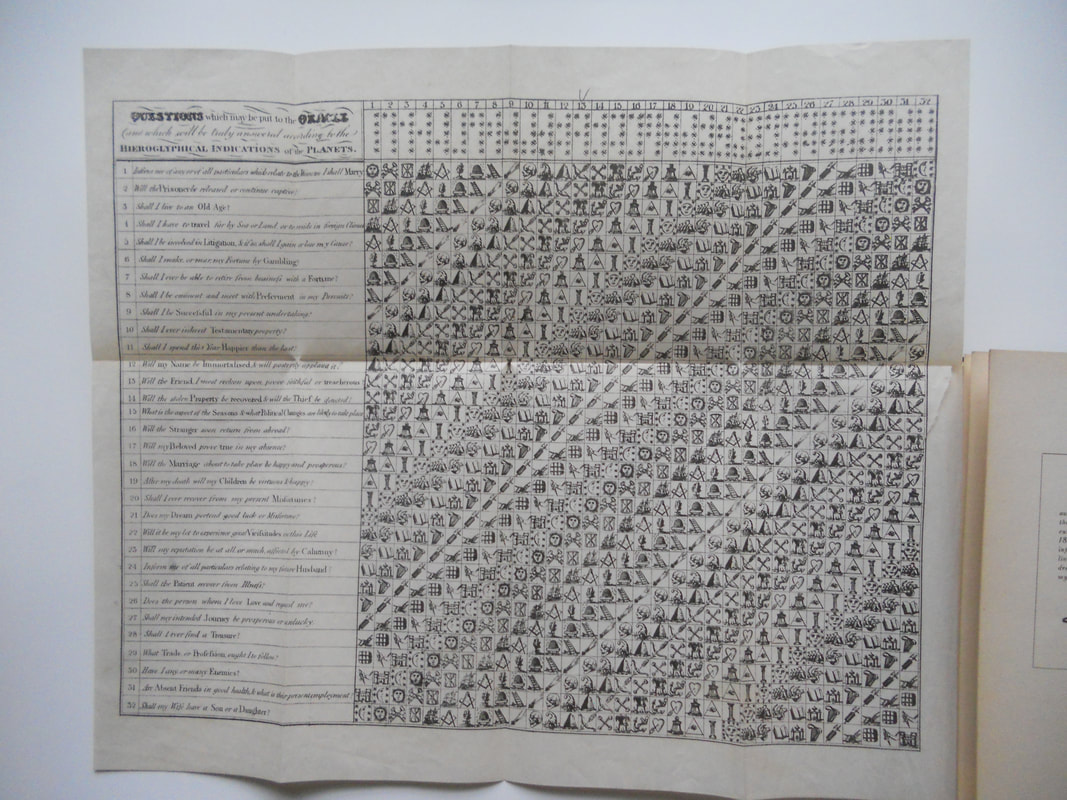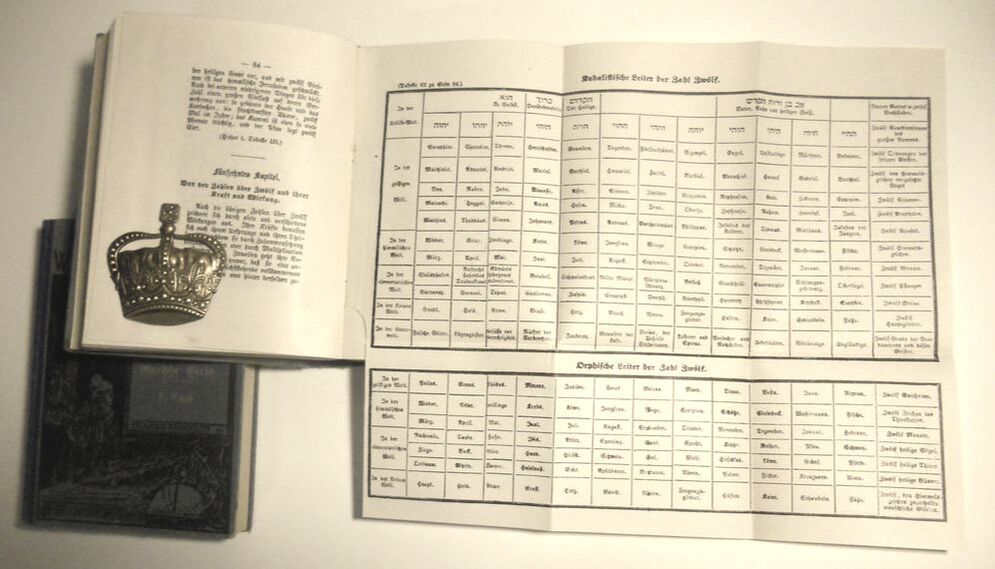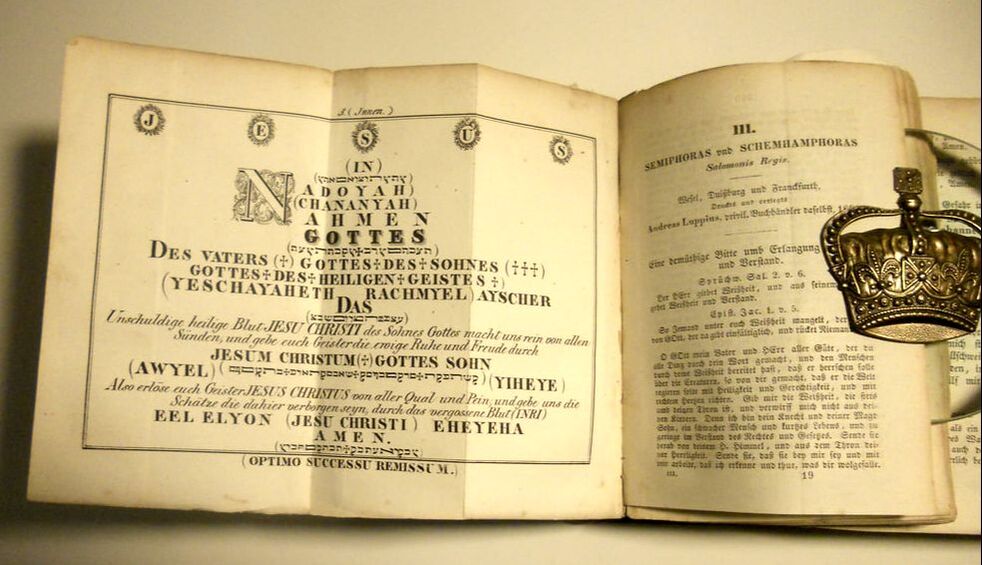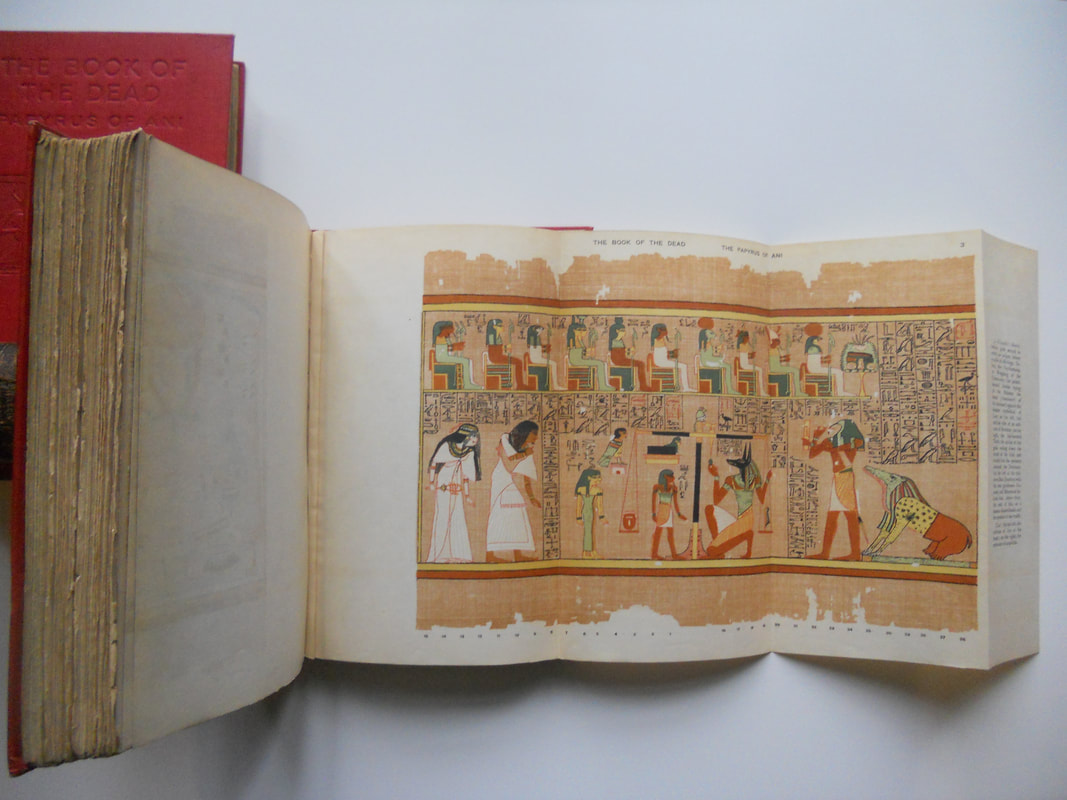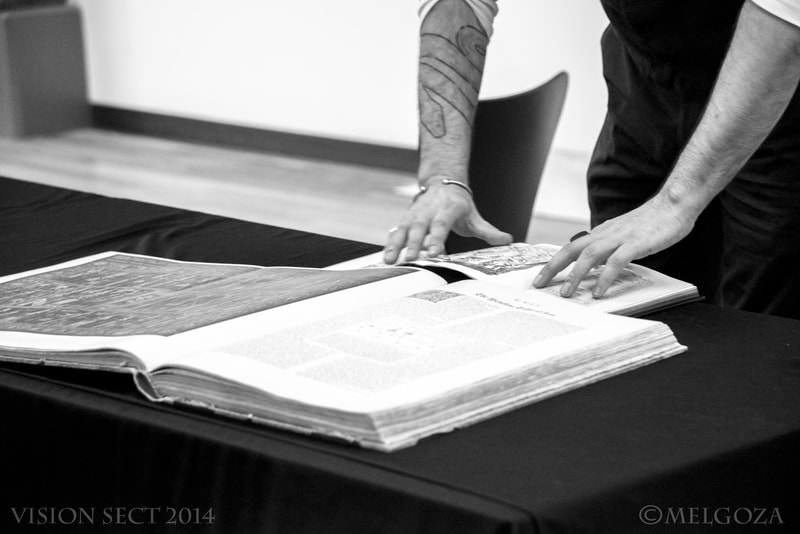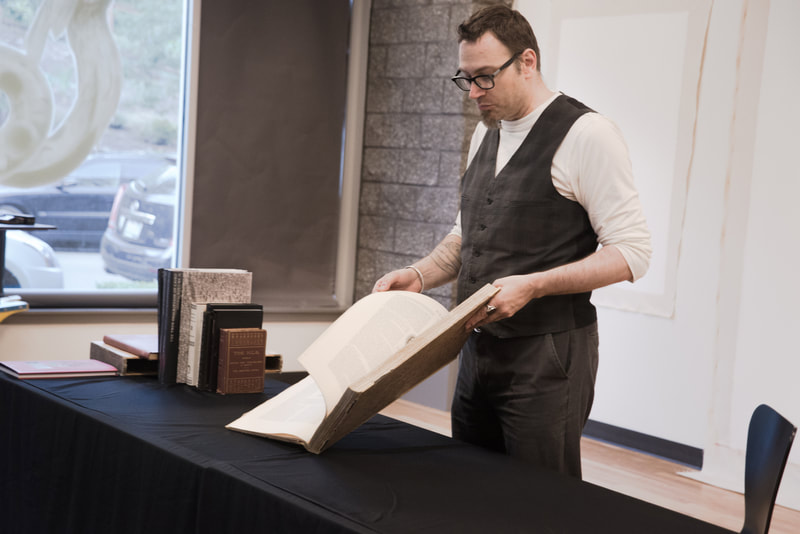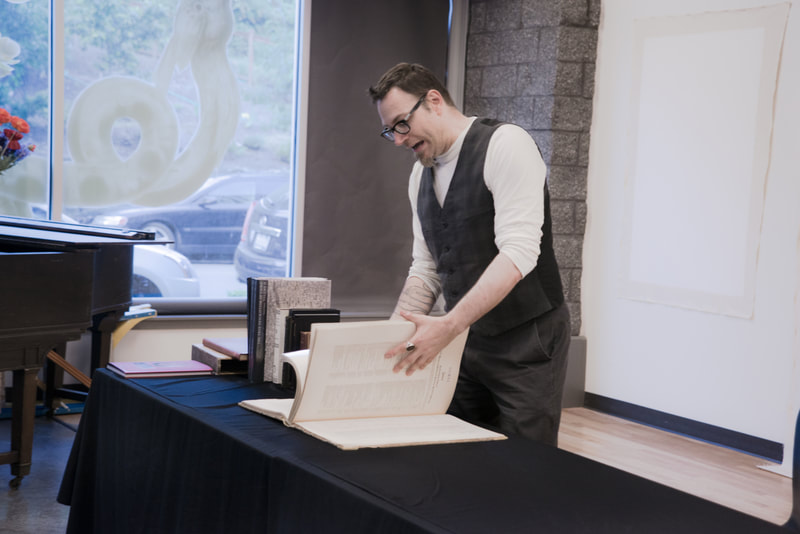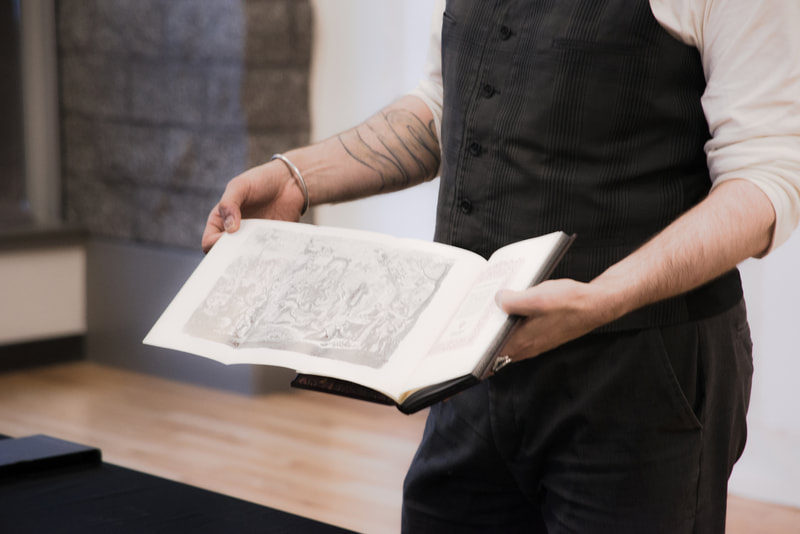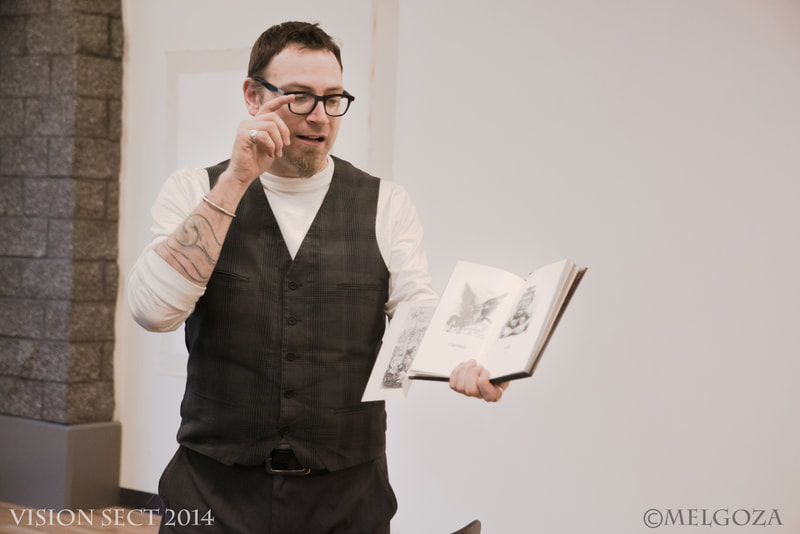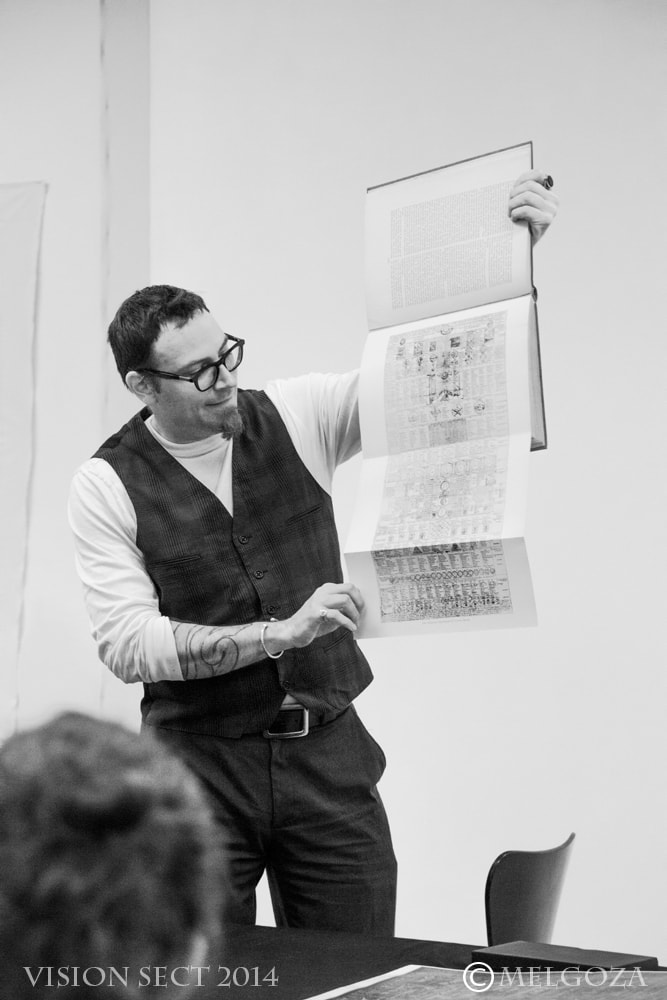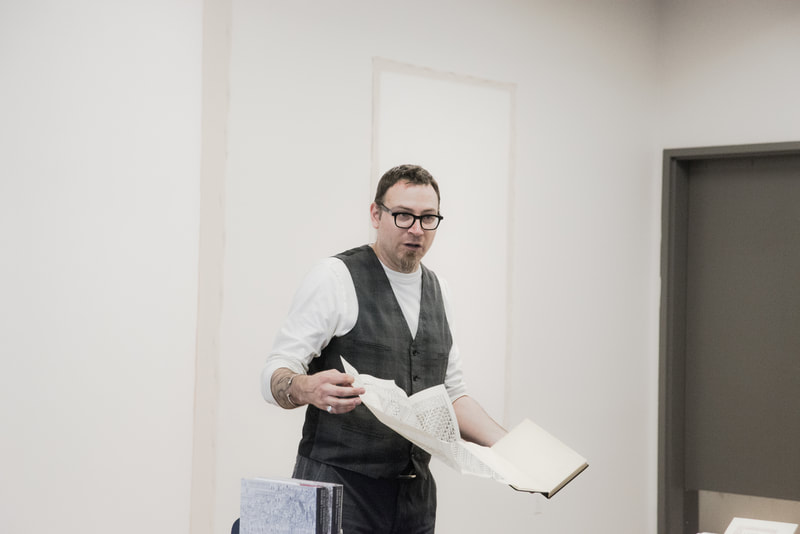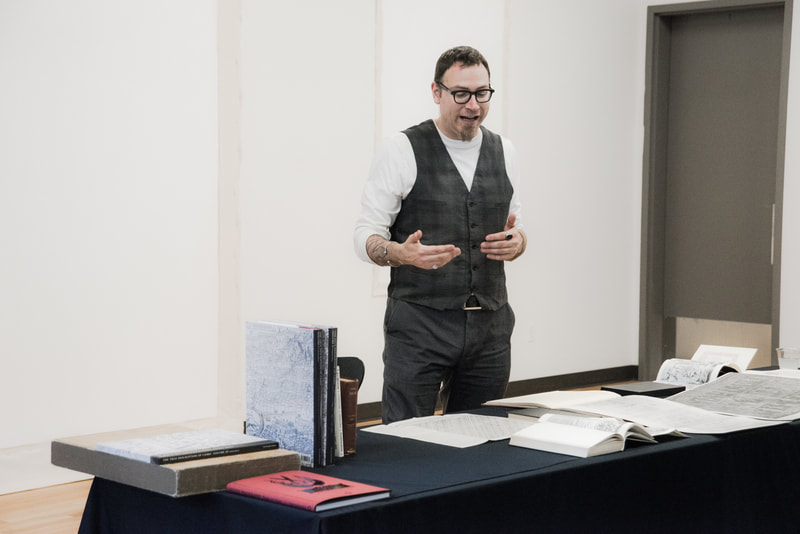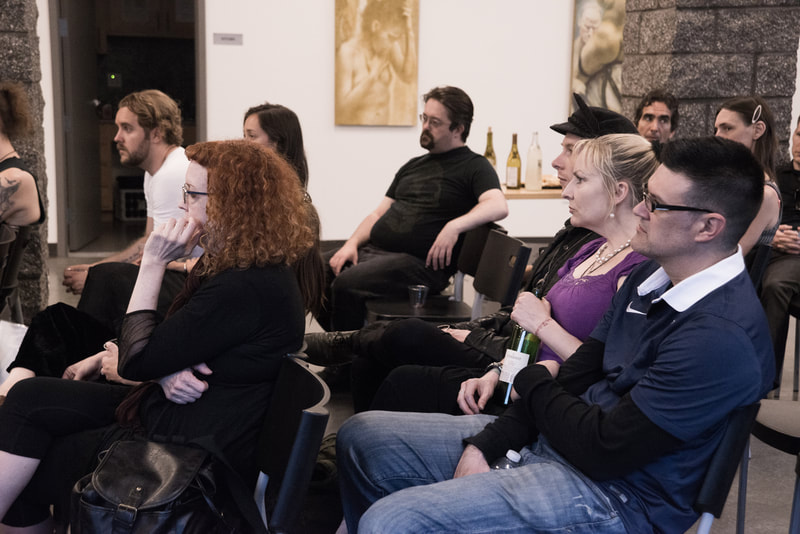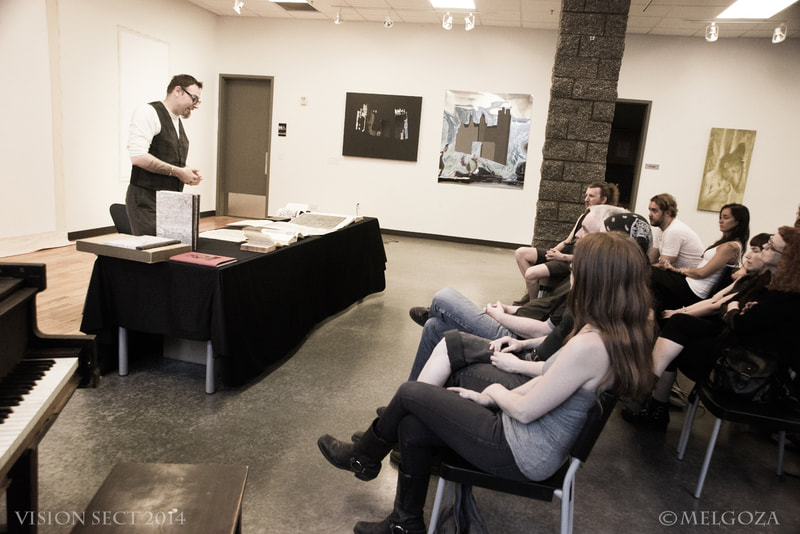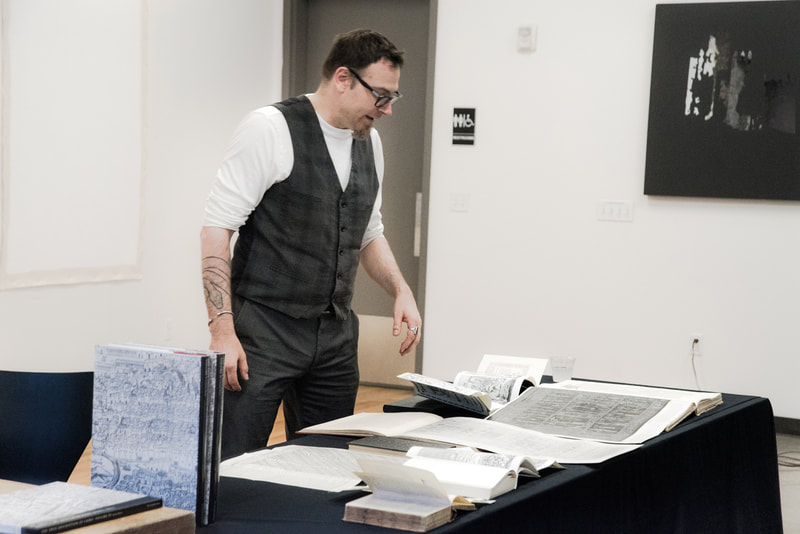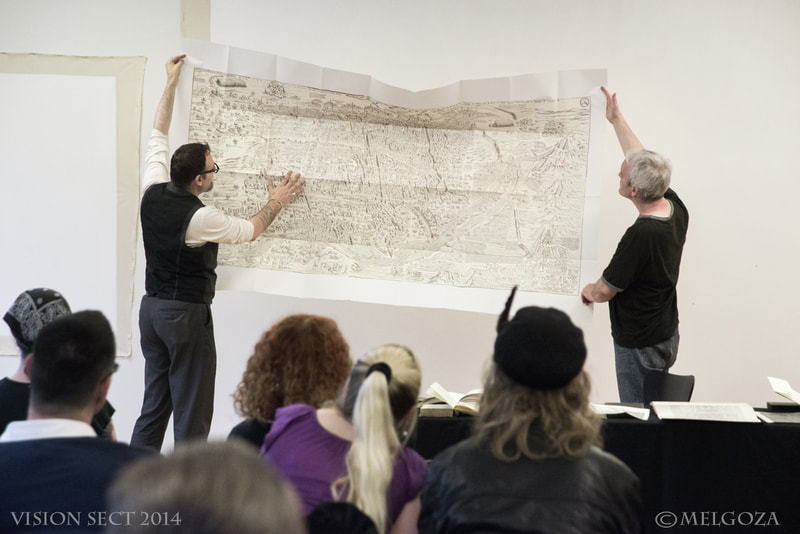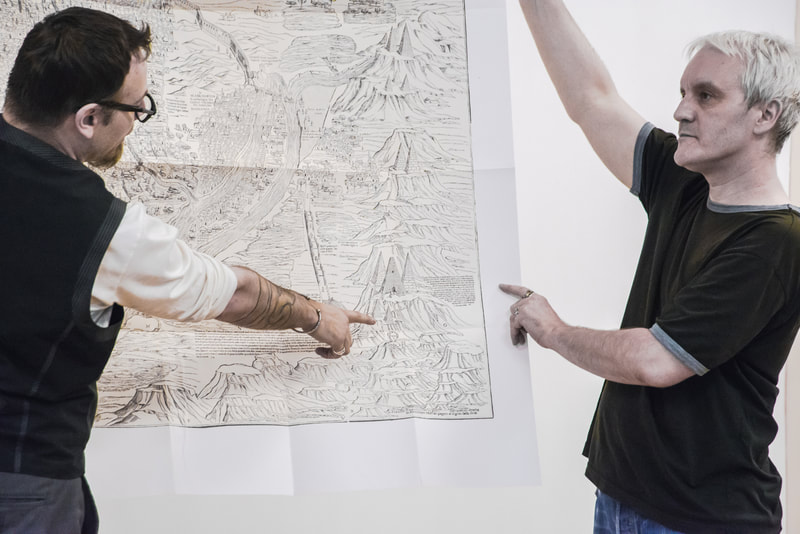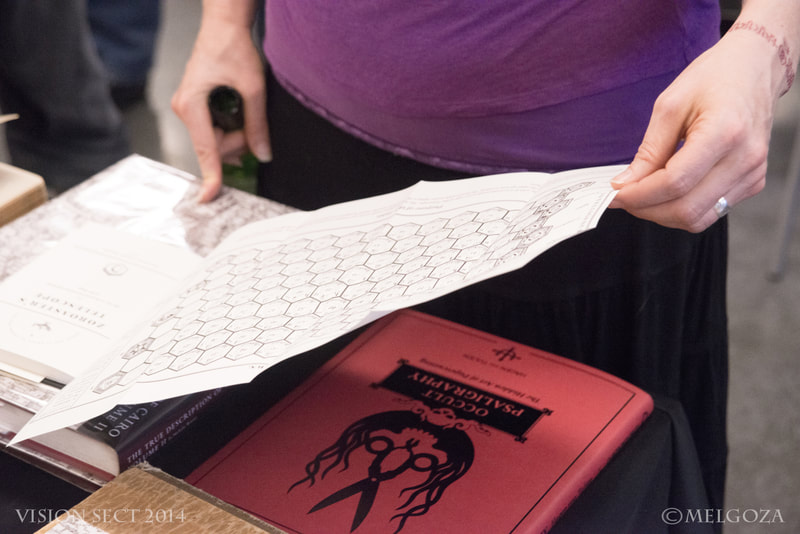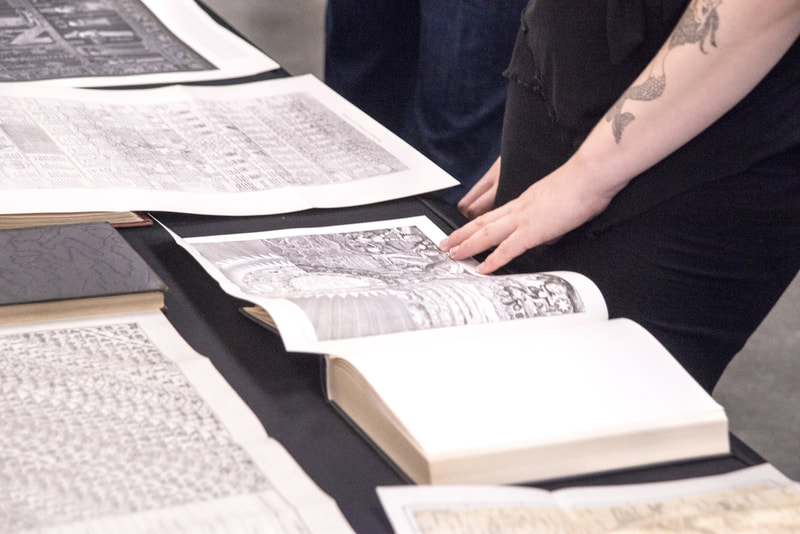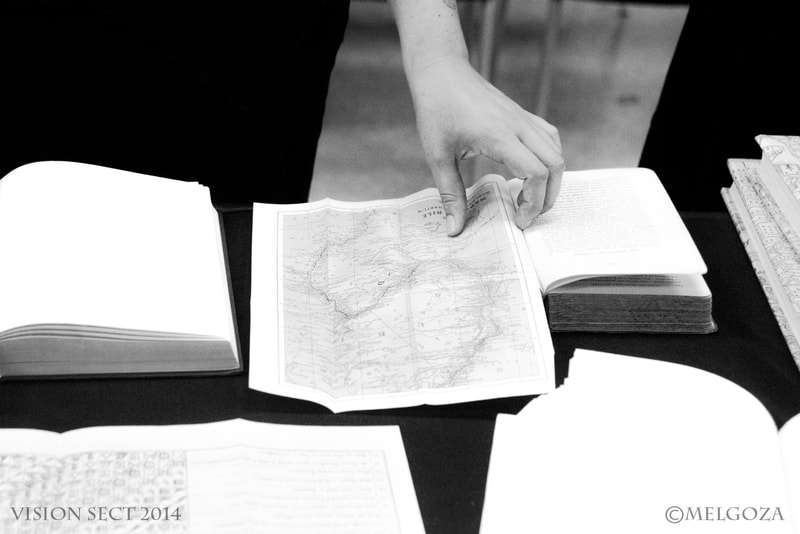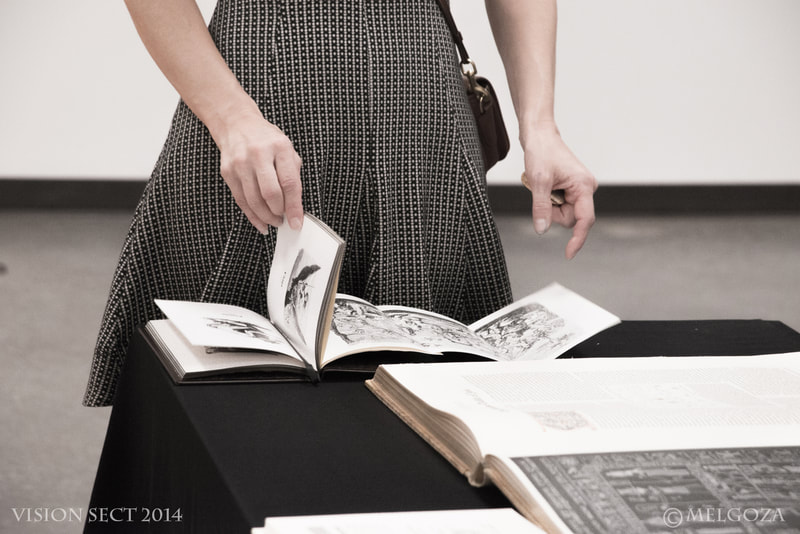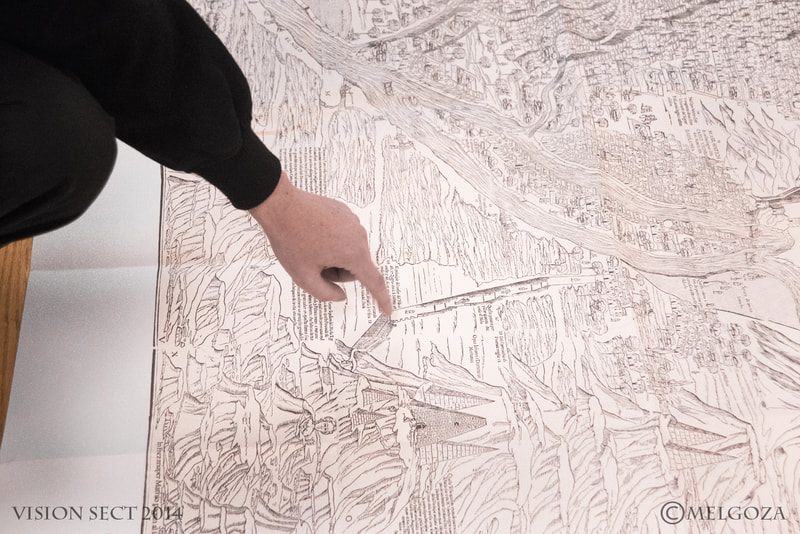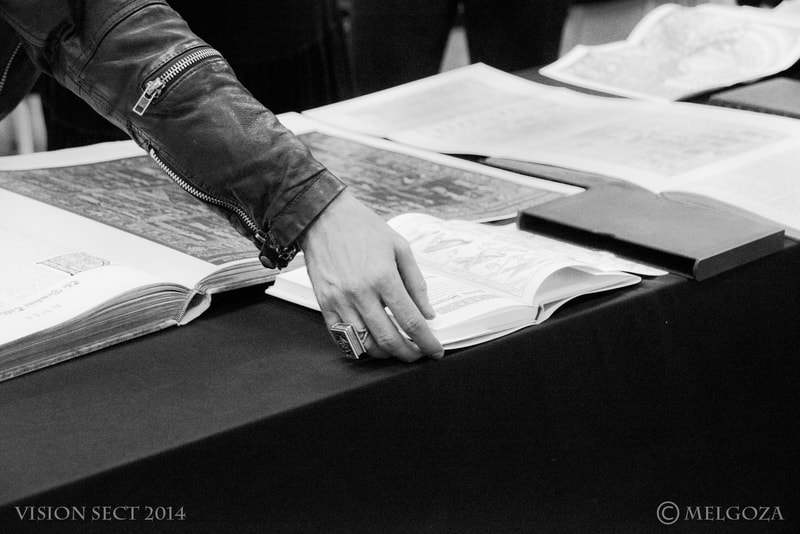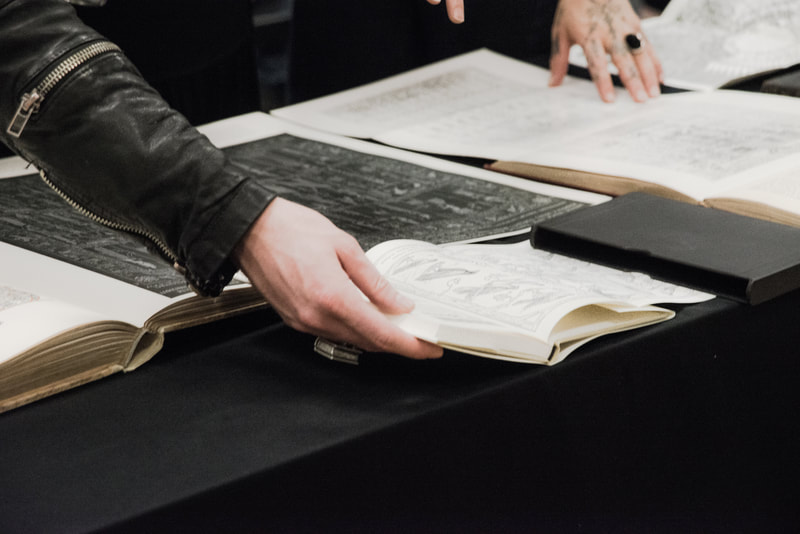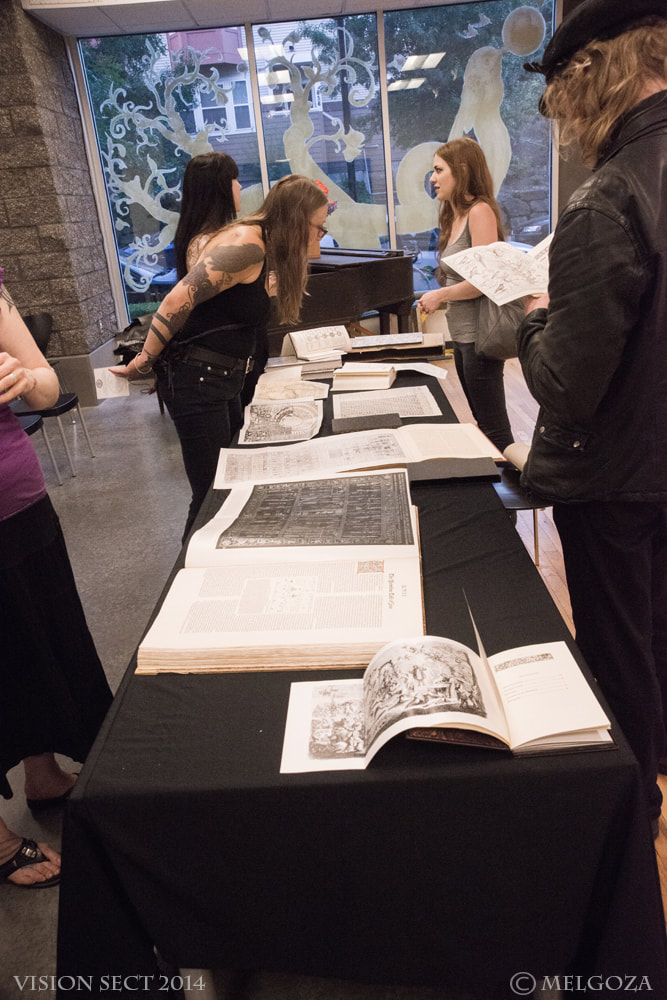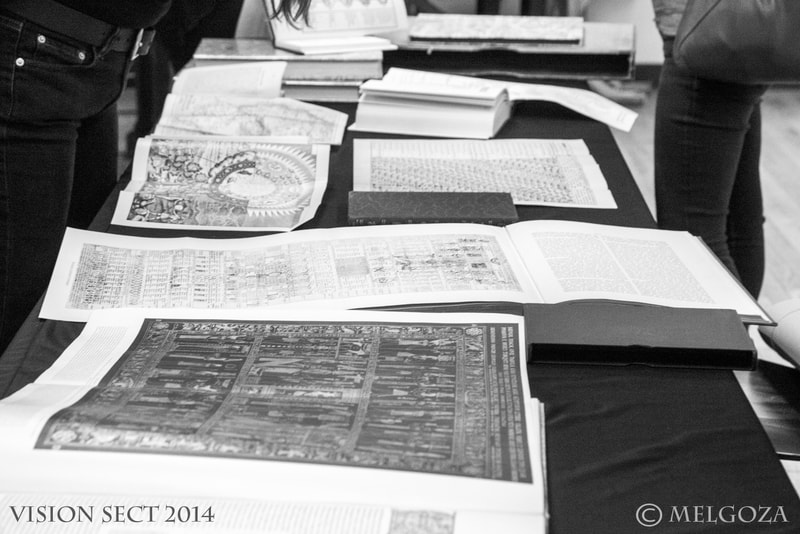Folding Plates in Esoteric Literature
This essay is based on a presentation William Kiesel gave at a publishing event and was later published by the Book Club of Washington.
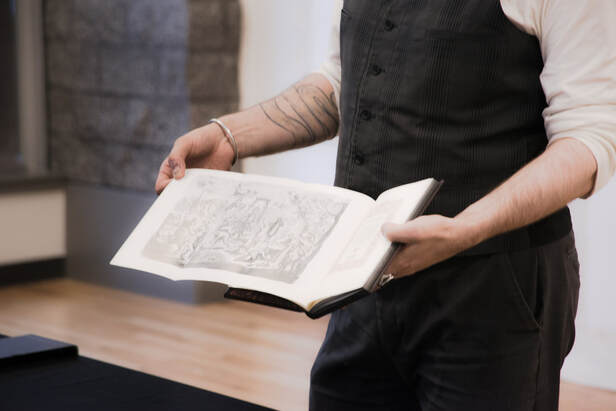 William Kiesel displaying a folding plate in Demonographia.
William Kiesel displaying a folding plate in Demonographia.
Books of esotericism are recognized from their ample use of symbolism to communicate aspects of their disciplines and are replete with visionary and artful expression. Though the ingenuity of typographers, printer and bookmakers are legion, there are two principal forms of folding plates. The fold-out is the type most recognized as being bound directly into the gutter of the book, whereas the throw-out is bound in such a way that the full plate may be viewed even if other pages of the book are consulted. In my years as a collector, bookseller and publisher I have always been particularly attracted to esoteric books. When I say esoteric, and mean it in the opposite sense as its antonym exoteric. Thus Theosophy, Freemasonry, Alchemy, Gnosticism, Hermeticism, Neoplatonism, Pythagoreanism and the Grimoires are among such literature. Books on esotericism deal not with surface issues but rather concern the ‘inner’ aspects of a subject, that which looks beyond the surface. With esoteric literature, communicating such material clearly requires authors, artists and publishers to use every tool at their disposal to convey quite subtle and sometime obtuse ideas.
Whether approached in the language of laboratory, or in the illuminated pages of monastic scribes, visual aids came in the form of emblemata, tables, charts and folding plates. Often the long list of correspondences were composed in the form of great tables, requiring the material to be printed on an over-size sheet intended to be bound into the volume as a folding plate.1 Books used as reference tools are often designed with the ease of reference in mind. In cases where the folding plate is an image it allows for a larger view of art integral to the subject.
A folding plate is an aspect of a specialized anatomy of book art sometimes called 'movable books'. Pop-up books, well known in children's literature are the most popular form of the moving book, but folding plates and volvelles preceded them and had more practical utility. For example Ramon Llull the Catalan Kabalist used volvelle dials in his many works on the Ars Notoria and Memoria. Some folding plates were made to show the architectural plans, temple layout or topographical materials. I have seen foldouts which exhibit long processions for religious festivals or even blocking for ritual performance. Freemasonic literature is not absent from the practice of employing folding plates in printed editions. Trestle boards, plans of Solomon's Temple and ritual instructions are often found represented in the medium.
Opening a folding plate causes an interruption in the reading process. It offers the reader an opportunity to think about what was read while contemplating the materials on the printed sheet. Again alchemy and mysticism share this meditative approach, a kind of inner reading read through the visual language of the birds or abecedarium.
A few exemplars follow with images from my own collection:
Manly Palmer Hall was no stranger to book arts, his private collection was certainly the largest in North America on the subjects of alchemy, freemasonry, esotericism, comparative religion and the occult. Not only did he collect rare books and manuscripts concerning these subjects, but he also produced excellent volumes.
Whether approached in the language of laboratory, or in the illuminated pages of monastic scribes, visual aids came in the form of emblemata, tables, charts and folding plates. Often the long list of correspondences were composed in the form of great tables, requiring the material to be printed on an over-size sheet intended to be bound into the volume as a folding plate.1 Books used as reference tools are often designed with the ease of reference in mind. In cases where the folding plate is an image it allows for a larger view of art integral to the subject.
A folding plate is an aspect of a specialized anatomy of book art sometimes called 'movable books'. Pop-up books, well known in children's literature are the most popular form of the moving book, but folding plates and volvelles preceded them and had more practical utility. For example Ramon Llull the Catalan Kabalist used volvelle dials in his many works on the Ars Notoria and Memoria. Some folding plates were made to show the architectural plans, temple layout or topographical materials. I have seen foldouts which exhibit long processions for religious festivals or even blocking for ritual performance. Freemasonic literature is not absent from the practice of employing folding plates in printed editions. Trestle boards, plans of Solomon's Temple and ritual instructions are often found represented in the medium.
Opening a folding plate causes an interruption in the reading process. It offers the reader an opportunity to think about what was read while contemplating the materials on the printed sheet. Again alchemy and mysticism share this meditative approach, a kind of inner reading read through the visual language of the birds or abecedarium.
A few exemplars follow with images from my own collection:
Manly Palmer Hall was no stranger to book arts, his private collection was certainly the largest in North America on the subjects of alchemy, freemasonry, esotericism, comparative religion and the occult. Not only did he collect rare books and manuscripts concerning these subjects, but he also produced excellent volumes.
The Secret Teachings of All Ages by Manly Palmer Hall. Published when the author was just 28 years old, the first five editions were sold out prior to printing. Designed by John Henry Nash, this elephant folio volume boasted several colors in letterpress and many color illustrations, including two folding plates. One of the plates was reproduced from a volume Hall owned Oedipus Aegypticus by Athanasius Kircher and depicted the Tabula Bembina with silver ink on a field of black. The second folding plate on the Hermetic Mystery was executed by J. Augustus Knapp, the artist who produced the full color plates opening each chapter of the book. Trained as a printer in Canada, Nash was well known for his lavish style, particularly during the 1920s, the period when the Secret Teachings was produced. During this time Nash worked in the Bay Area, notably for Paul Elder & Company and later the Arion Press. John Henry Nash's attention to detail and drive for fine printing spearheaded the movement for fine press publications which survives to this day.
|
Codex Rosicrucis, also by Manly P. Hall and published in a large format quarto posses a folding plate of the Magical Calendar of Tycho Brahe in the introductory materials preceding the facsimile of the D.O.M.A. manuscript which forms the main body of this Rosicrucian text. The foldout is not a calendar in the modern sense of the term, instead it showed a very detailed table of correspondences, numerologically arranged from a single unity represented by God and dividing into the dyad, triplicities, quaternary, quintuple and so on. Besides enumerating the numeric symbolism the table also demonstrates the cabalistic doctrine of emanation.
In Major General Forlong's Rivers of Life or Faiths of Man in All Lands* a huge folding plate measuring several feet chronicles the the history of religions as various tributaries stemming from a single river source. The foldout is titled: 'A Student's Synchronological Chart of the Religions of the World.' The chart shows the 'principle characters, cities and leading religious events, historical and mythical,' together with 'Objects of worship, deities, incarnations, and faith streams' and even; 'principal matters in bibles, theological works, dogmas, missions, languages, &c.' in a timeline format starting at 10,000 BC until 1900. The foldout is printed in eight colors for ease of reference and the various religions are represented by the following currents: Tree Worship, Phallic Worship, Serpent Worship, Fire Worship, Sun Worship and Ancestor Worship. * Quaritch: London; Edinburgh. 1883. |
The Theatrum Chemicum Britannicum is a collection of English alchemical poetry compiled by the antiquarian Elias Ashmole. In addition to several engravings depicting alchemical laboratories, astrological charts and famous adepts, there is a folding plate which is to be found in the Compound of Alchemie, or Twelve Gates by George Ripley. This typographical diagram labeled; ‘Here followeth the the Figure conteyning all the secrets of the Treatise both great & small‘ was originally rendered by John Goddard. In keeping with the original the folding plate is included in the Ouroboros Press edition with the Latin parts translated into English.
Jocus Severus: A Serious Joke was written by Count Michael Maier* who was the court physician to Rudolf II in 17th century Prague. The book is a humorous account of the Owl being put on trial by several species of birds, the defense taken up by the Hawk and with the judge being the Phoenix. Through a series of cross exhaminations each bird in turn tries to lobby the judge to appoint them as the wisest of the birds, the whole trial being an allegory for the persecution of alchemical thought [here in the form of the Owl]. While the original of 1617 merely showed the birds on the title page alone, I decided to hire artist Benjamin Vierling to render the Alchemical Aviary to be shown upon a folded plate adjacent to the title page. Each of the birds in the story are represented in an ornamental illustration that allows the reader to visualize the birds in their proper form.
* For more on Maier see Hereward Tilton, The Quest for the Phoenix: Spiritual Alchemy and Rosicrucianism in the Work of Count Michael Maier (1569-1622) de Gruyter, 2003
* For more on Maier see Hereward Tilton, The Quest for the Phoenix: Spiritual Alchemy and Rosicrucianism in the Work of Count Michael Maier (1569-1622) de Gruyter, 2003
Zoroaster's Telescope: The Key to the great divinatory Kabbala of the Magi. This tome is a grimoire attributed to Zoroaster, and is a Kabbalistic system of divination which utilizes astrological and angelic forces after a curious manner. Illustrated with occult tables, diagrams and charts in exquisite woodcuts, the large folding plate entitled: THE URN, shows an array of hexagonal pieces which comprise the various parts of the oracle described in the book. The edition shown is taken from Das Kloster* although Ouroboros Press has issued the first English translation that also features the folding plate.
* Das Kloster. Weltlich und geistlich. Meist aus der altern deutschen Volks-, Wunder-, Curiositaten-, und vorzugsweise komischen Literatur. 12 volumes edited by Johann Scheible: 1845-1849.
* Das Kloster. Weltlich und geistlich. Meist aus der altern deutschen Volks-, Wunder-, Curiositaten-, und vorzugsweise komischen Literatur. 12 volumes edited by Johann Scheible: 1845-1849.
Napoleon's Book of Fate. Like Zoroaster's Telescope, the Book of Fate represents a curious type of divination originally used by Napoleon Bonaparte and later found its way into victorian parlors as a form of both serious and light-hearted pastime for the wealthy. A long list of questions suitable for the oracle are delineated and the system of divination employs a series of figures chosen at random which are represented on the foldout in the front of the book. The title text on the foldout reads: “Questions which may be put to the Oracle and which will be answered according to the HIEROGLYPHICAL INDICATIONS of the PLANETS.” The plate is printed and bound as a throwout, allowing easy reference to the chart while cross referencing the oracular meaning found in the text.
De Occulta Philosophia. Heinrich Cornelius Agrippa von Nettesheim. One of the most influential occult books of the early renaissance. The edition cited here is a facsimile edition published in a German esoteric journal 'Gehimen . . . ' Agrippa was a compiler of occult lore, doctrine and practices including Neoplatonic mysticism, Cabala, talismanic magic and secret writing. Several foldouts are included in the set showing charts with number symbolism, magic squares and instructions for letter permutation for the generation of spirit names.
Semiphoras et Shemhamphoras Solomon Regis. A collection of divine names meant to have power over esoteric forces in the universe, lists of angels and hierarchies of spirits with their names and attributes. The present edition cited is taken from Das Kloster.
[Folding plate showing alchemical emblemata in the Green Lion Edition of Turba Philosophorum.]
[Folding plate showing alchemical emblemata in the Green Lion Edition of Turba Philosophorum.]
Egyptian Book of the Dead
Some folding plates serve as a means to show texts in their original language, usually in facsimile. The first edition of E. A. Budge's The Book of the Dead contains multiple folding plates which show the hand painted papyri from which his early translation was made.
**
Folding plates tend to be rare today, perhaps due to the perception that the digital medium has become the norm. As a book maker I think it is integral to my craft that I continue to represent different forms of the book in the modern era. It is my hope that by producing books with traditional elements I might be supporting the legacy of fine book making.
I encourage all interested parties to explore local libraries and archives in order to view folding plates such as those described above. The satisfaction engendered by such a viewing will be palpable, being one of the benefits of traditional book arts.
ABOUT THE AUTHOR: William Kiesel is the publishing director of Ouroboros Press, co-editor of CLAVIS: Occult Arts, Letters and Experience and the founder of the Texts & Traditions Colloquium. With two decades of antiquarian bookselling as a foundation, Kiesel is also an avid supporter of the Book Arts.
Some folding plates serve as a means to show texts in their original language, usually in facsimile. The first edition of E. A. Budge's The Book of the Dead contains multiple folding plates which show the hand painted papyri from which his early translation was made.
**
Folding plates tend to be rare today, perhaps due to the perception that the digital medium has become the norm. As a book maker I think it is integral to my craft that I continue to represent different forms of the book in the modern era. It is my hope that by producing books with traditional elements I might be supporting the legacy of fine book making.
I encourage all interested parties to explore local libraries and archives in order to view folding plates such as those described above. The satisfaction engendered by such a viewing will be palpable, being one of the benefits of traditional book arts.
ABOUT THE AUTHOR: William Kiesel is the publishing director of Ouroboros Press, co-editor of CLAVIS: Occult Arts, Letters and Experience and the founder of the Texts & Traditions Colloquium. With two decades of antiquarian bookselling as a foundation, Kiesel is also an avid supporter of the Book Arts.
